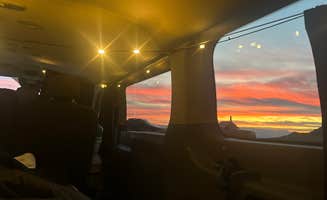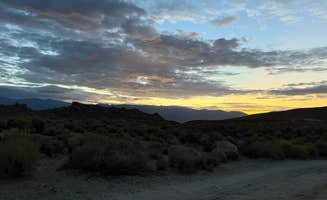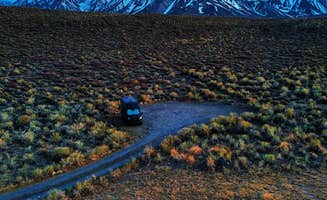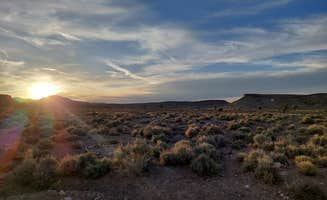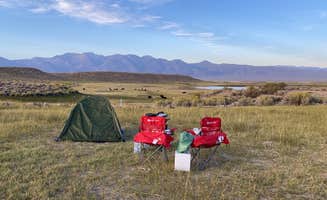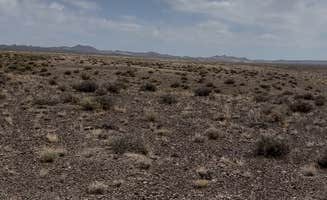Dispersed camping near Dyer, Nevada allows visitors to experience the high desert at elevations ranging from 4,900 to over 6,000 feet. The region sits between the White Mountains to the west and the Silver Peak Range to the east, creating a rain shadow effect that results in arid conditions year-round. Summer daytime temperatures often exceed 90°F while winter nights can drop well below freezing.
What to do
Wildlife viewing opportunities: The area around Fish Lake Valley Hot Springs attracts diverse wildlife beyond just the springs themselves. "A lot of animals near the water (frogs, ducks, birds, cows, fishes)" notes Clara T., who camped here in 2024.
Star photography: The minimal light pollution makes for exceptional night photography conditions at Volcanic Tableland BLM Dispersed Camping. "I drove in at night and the Milky Way was shining bright. Got some decent star shots," reports Jibran B., who found this area to be a convenient stopover.
Off-road exploration: The terrain around Dyer offers numerous routes for 4x4 vehicles. "You'll need a 4 x 4 to reach a lot of the areas that are up on the hills," advises a camper about Poleta OHV areas. Stick to established routes and check seasonal closures before planning trips.
What campers like
Hot springs accessibility: Many visitors appreciate the various hot springs temperatures at Fish Lake Valley. "There is a man-made pool and then several concentric pools coming out from that each cooler in temperature," shares Matt G., who considers it "the best hot springs in Nevada."
Mountain vistas: The panoramic views draw many campers to these dispersed sites. At McGee Creek, Larry E. describes the setting as "peaceful and far away from any highway" with "beautiful views of the mountains in the morning."
Cell service in remote locations: Unlike many wilderness areas, some dispersed sites near Dyer maintain usable communications. At Poleta OHV Upper Staging Area, one camper notes, "There are a few cell towers around so I had full coverage with T-Mobile as well."
Spacious campsites: Many locations offer ample room between sites. Jessica at Volcanic Tableland reports, "Sites are spaced apart to where it feels like you're the only one in the area."
What you should know
Road condition variability: Access roads range from decent to challenging depending on recent weather and location. For Crab Cooker Hotsprings, Thomas K. warns, "4x4 or high clearance coming in. Long dirt road with dips and rocks."
Seasonal water flow: Hot springs may change throughout the year. At Crab Cooker, a camper noted "Water only flowing in winter months," which affects the temperature and usability of the springs.
Weekday vs. weekend crowds: Several locations experience significant differences in visitor numbers. "I was here mid week and there's hardly anybody here, I imagine on the weekend it probably gets more crowded and is an ATV/off-road area that's probably a little more loud," reports a camper at Poleta OHV area.
Wind exposure: The open terrain offers little protection from weather. At Tonopah Dispersed Camping, one reviewer experienced, "We did arrive in the heat, kept screened windows open through the night, and awoke to a sand filled living space and cooler temps."
Tips for camping with families
Hot springs temperature monitoring: When visiting thermal areas with children, check temperatures first. At Deep Canyon, which provides access to nearby springs, families should note that some pools can reach scalding temperatures requiring careful supervision.
Wildlife education opportunities: The diverse ecosystem offers learning experiences. Tyler D. describes Deep Canyon as a "former river bed I assume," providing opportunities to discuss geology and habitat formation with children.
Easy-access hiking: Several locations feature beginner-friendly trails. Beth M. recommends McGee Creek Trail, noting it's "only a couple of miles away and is fantastic, easy hiking."
Bathroom availability planning: Most dispersed sites lack facilities. Fish Lake Hot Springs is an exception, with Clara T. noting, "There is toilets," making it more suitable for families with young children.
Tips from RVers
Length restrictions: Many roads to prime dispersed camping locations have limitations. At McGee Creek, a reviewer warns that their previous experience showed "only about two spots before you hit a boulder in the middle of the path."
Leveling challenges: The terrain can make setting up difficult in some areas. At Tonopah Dispersed Camping, one RVer advises to "take the middle road choice when starting out at the BLM office. Stop at the crest of the hill. It goes downhill from there with no turn around for a big trailer and is softer sand."
Full-timer experiences: Long-term RVers have tested the practicality of these sites. Ray & Terri F., full-timers with a "36 ft Class A with a Cherokee Trailhawk tow," found Fish Lake Valley workable for a multi-night stay with good satellite coverage despite no AT&T service.
Overnight positioning: Strategic parking matters for comfort. Lyf Uninterrupted recommends the Tonopah dispersed area because it's "level" and "easy to get in and out" while offering overnight positioning with scenic views.



